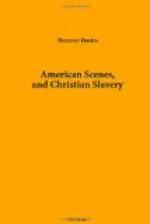Soon after our arrival the Rev. Dr. Bacon and the Rev. Mr. Dutton, the pastors of the “first” and “second” Congregational Churches in this city, honour us with a call. This is brotherly, and more than we could have expected. Dr. Bacon regrets that he is going from home, and cannot have us to spend a few days at his house. Mr. Dutton, however, presses us to accept of his hospitality. We promise to do so in a day or two. Dr. Bacon is one of the great men of New England. He is a living encyclopaedia,—a walking library. He keeps fully up with the literature and sciences of the day. I have not met a man, either in the Old World or in the New, that so thoroughly understood the state of the British West Indies at the present time as he does. He might have spent years in that part of the world, and devoted himself to its exclusive study. His position at home is high, and his influence great. The estimation in which he is held in New England may be judged of by the fact, that when, in August 1846, Dr. Theodore Dwight Woolsey had to be installed as President of Yale College, Dr. Bacon, living within a stone’s throw of that institution, was the man chosen to preach the inauguration sermon.
In the middle of the afternoon, my friend Mr. Sawyer presses me to preach in his place of worship—the Howe-street Church—this evening. I consent. By-and-by I observe him very busy with some slips of paper; and I ask him what he is doing? “I am sending,” he says, “notices to the evening papers, to make it known that you are going to preach this evening!” What a people the Americans are for newspapers! New Haven has only a population of about 18,000; and yet it has six daily papers—all having a weekly issue besides, two monthly periodicals, and two quarterly ones! The daily papers are, I believe, none of them more than 5 dollars (a guinea) a year, or 2 cents (one penny) per number. No paper duty, and no stamp. At the service in the evening several ministers and students were present.
The next day snow to the depth of six inches cover the ground. Let us, however, turn out in the afternoon. We will go and see the central square,—or the Green, as it is commonly called. This is a large open space like a park, surrounded on all sides with rows of stately elms, and is considered one of the most beautiful spots in the United States. And now we are in a position to take a full view. Three churches, arranged side by side on this open space, at a few rods from each other, stand before us. The central one has the most imposing aspect. It is a large Grecian building; having a portico, supported by four massive columns, from which rises a lofty bell-tower, ending in a spire. The combination of the belfry or spire with the Grecian style is a violation of propriety; but I like it. This is the “first” Congregational Church—that in which Dr. Bacon ministers. That church—not the building—is coeval with the colony, and




